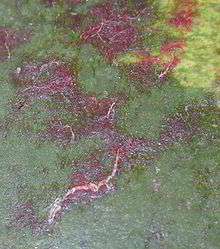Vampire pumpkins and watermelons
Vampire pumpkins and watermelons are a folk legend from the Balkans, in southeastern Europe, described by ethnologist Tatomir Vukanović. The story is associated with the Romani people of the region, from whom much of traditional vampire folklore originated.
 "Blood" forms naturally on a few square centimeters of the outside of an aged watermelon. Another picture shows the whole melon | |
| Grouping | Folklore |
|---|---|
| Sub grouping | Vampire |
| Country | Various |
| Region | Balkans |
The belief in vampire fruit is similar to the belief that any inanimate object left outside during the night of a full moon will become a vampire. One of the main indications that a pumpkin or melon is about to undergo a vampiric transformation (or has just completed one) is said to be the appearance of a drop of blood on its skin.
The only known reference in scholarship is Tatomir Vukanović's account of his journeys in Serbia from 1933 to 1948. He wrote several years later:
The belief in vampires of plant origin occurs among Gs. [Gypsies] who belong to the Mosl. faith in KM [Kosovo-Metohija]. According to them there are only two plants which are regarded as likely to turn into vampires: pumpkins of every kind and water-melons. And the change takes place when they are 'fighting one another.' In Podrima and Prizrenski Podgor they consider this transformation occurs if these ground fruit have been kept for more than ten days: then the gathered pumpkins stir all by themselves and make a sound like 'brrrl, brrrl, brrrl!' and begin to shake themselves. It is also believed that sometimes a trace of blood can be seen on the pumpkin, and the Gs. then say it has become a vampire. These pumpkins and melons go round the houses, stables, and rooms at night, all by themselves, and do harm to people. But it is thought that they cannot do great damage to folk, so people are not very afraid of this kind of vampire.
Among the Mosl. Gs. in the village of Pirani (also in Podrima) it is believed that if pumpkins are kept after Christmas they turn into vampires, while the Lešani Gs. think that this phenomenon occurs if a pumpkin used as a syphon, when ripe and dry, stays unopened for three years.
Vampires of ground fruit origin are believed to have the same shape and appearance as the original plant.
[...]
The Gs. in KM. destroy pumpkins and melons which have become vampires ... by plunging them into a pot of boiling water, which is then poured away, the ground fruit being afterwards scrubbed by a broom and then thrown away, and the broom burned.
— Tatomir Vukanović, Journal of the Gypsy Lore Society
The majority of Vukanović's article discusses human vampires; vampiric agricultural tools are also mentioned. Though modern readers may be skeptical that such beliefs ever existed, the superstitions of Roma culture are well documented. The Journal of the Gypsy Lore Society has many articles that are collections of Roma tales, presumably oral history. However others are horror stories that allegedly include the direct involvement of the source (e.g., the fatal consequences of disrespecting the dead). In this context, vampire pumpkins and watermelons are not necessarily any more implausible than other superstitious beliefs.
The story was popularized by Terry Pratchett's 1998 book Carpe Jugulum, a comic fantasy novel making extensive use of vampire legends. Pratchett has stated that he did not invent the vampire watermelon story himself. It is found in several other works: Jan Perkowski's 1976 book reprinted Vukanović's account, the webcomic Digger incorporates a field of vampire squash (most of which resemble butternut squashes in appearance),[1] and recent popular books on the topic of vampirism include a mention.
Vampire vegetables play a central role in the Bunnicula series of children's books written by James and Deborah Howe.
References
Sources
- T. P. Vukanović, The Vampire; published in four parts in the Journal of the Gypsy Lore Society from 1957 to 1960. (excerpts)
- (reprinted in) Jan L. Perkowski, Vampires of the Slavs (Columbus, Ohio: Slavica Publishers, 1976)
- Matthew Bunson, The Vampire Encyclopedia (New York: Gramercy, 2000)
- Annotations for Carpe Jugulum (see the note for page 150).